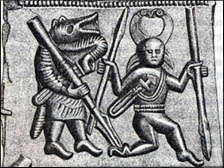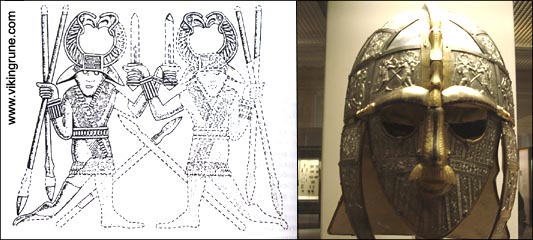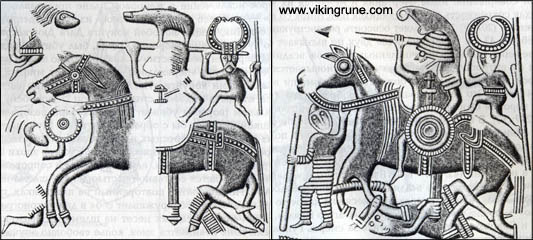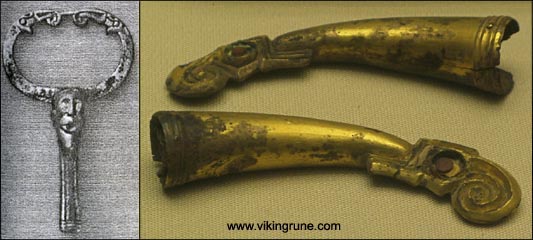 To the left is the mirrored image of one of the four cast-bronze dies from Torslunda, which were used for striking helmet-plates. It is mirrored advisedly, in order to get the actual image that appeared on the helmets when the matrice was applied to them. This die (dated to c. 600) was found at Björnhovda in Torslunda on Öland. It is famous because of the bird-horned dancer, an image that gave rise to a lot of speculation. It was suggested that the man with two spears represents Odin, since berserkers and úlfhéðnar were special Odin’s warriors who wore pelts of bears and wolves. Correspondingly, the other figure on Torslunda die was interpreted as either bear-warrior or wolf-warrior. Identification of the bird-horned man as Odin was further endorsed with the aid of the Stockholm Archaeological Research Laboratory’s laser scanner, which mapped the surface of the matrice and proved that the man is one-eyed. It is interesting that the right eye on the matrice (the left one on the resulting helmet plate) was initially present, but removed with a sharp instrument during the manufacturing process. Note that the horned helmet (or horned hat) has strange “ears” below the horns. Another interesting fact is that the horned man is wounded by a spear in the heel. The same features are present on the so-called “dancing warrors” plate from the Sutton Hoo ceremonial helmet (dated to the 6th century):
To the left is the mirrored image of one of the four cast-bronze dies from Torslunda, which were used for striking helmet-plates. It is mirrored advisedly, in order to get the actual image that appeared on the helmets when the matrice was applied to them. This die (dated to c. 600) was found at Björnhovda in Torslunda on Öland. It is famous because of the bird-horned dancer, an image that gave rise to a lot of speculation. It was suggested that the man with two spears represents Odin, since berserkers and úlfhéðnar were special Odin’s warriors who wore pelts of bears and wolves. Correspondingly, the other figure on Torslunda die was interpreted as either bear-warrior or wolf-warrior. Identification of the bird-horned man as Odin was further endorsed with the aid of the Stockholm Archaeological Research Laboratory’s laser scanner, which mapped the surface of the matrice and proved that the man is one-eyed. It is interesting that the right eye on the matrice (the left one on the resulting helmet plate) was initially present, but removed with a sharp instrument during the manufacturing process. Note that the horned helmet (or horned hat) has strange “ears” below the horns. Another interesting fact is that the horned man is wounded by a spear in the heel. The same features are present on the so-called “dancing warrors” plate from the Sutton Hoo ceremonial helmet (dated to the 6th century):

The plate is on the front side of the helmet (photo above to the right by RahelH_, used under Creative Commons Attribution 2.0 Generic Licence), so the meaning it was supposed to convey was deemed to be very important. The protrusions on the warriors’ helmets also have bird heads, the helmets also have “ears” visible on Torslunda die discussed above. However, this image features another stage/variant of the sacred or ceremonial dance. Torslunda warrior holds two spears in both hands: one spearhead up and the other down, his sword being sheathed. Sutton Hoo weapon dancers hold both spears in one hand, both spearheads down. The unsheathed sword is in the other hand. At least one of the warriors (the other was reconstructed) wounds himself in the heel (or merely aims at his heel). Two more spears seem to emerge from the ground. Note the square element visible on the front side of the warriors’ helmets/hats. They also have their clothes on, while Torslunda man is naked, except for the belt and horned headgear. Ritual horned dancer from Finglesham buckle, holding two spears, also has nothing on, while the horned dancer from Ekhammar pendant (Kungsängen, Uppland), holding two spears in his left hand and a sword in his right hand, has his clothes on. Recurring pattern may indeed point to various stages/variants of the same widely spread ceremony/ritual performed by weapon dancers. Another changing item in the images of this type is the square element on the helmet/hat. Take a look at the plates from two Vendel period helmets: Valsgärde 7 (to the left) and Valsgärde 8 (to the right):

These images feature the same character, but in quite a different context: naked Odin directs a warrior’s spear, holding himself a spear in his left hand. On Valsgärde 7 plate the square element is present, while on Valsgärde 8 it is absent. Moreover, on Valsgärde 7 plate Odin does not have a belt, but has bird heads on the horns, while on Valsgärde 8 Odin has a belt on, but no bird heads. Yet another form of bird-horned Odin is a charm featuring only the Norse god’s head. This type is represented by the Anglo-Saxon 7th century object found at Soberton, Hampshire in 2002, and the Viking artefact found at Staraya Ladoga, Russia (below to the left).

The latter image is interesting in connection with two items displayed at the British Museum, London, as terminals of drinking horns (photo above to the right by Thorskegga, all rights reserved, used by permission). The similarity with Staraya Ladoga object is so striking, that one may suggest these two terminals were once used for a helmet/hat worn by weapon dancers during the ceremonies discussed above. As for Torslunda die image, its connection with berserkers or úlfhéðnar seems unlikely. If Odin protected berserkers, why one of them should wound him in the heel? I would rather connect this image with the idea of Odin’s encounter with the wolf Fenrir during the events accompanying the end of the present world (Ragnarök). If so, the image on another Torslunda matrice featuring a man with an axe who ties a large beast (also present on a plate from Vendel 1 helmet) may be an image of Tyr who ties Fenrir.

I was just looking for names, “Symbols” and saw your forum. Not sure what I’m looking for, asking. I lost my Grandson in 2016. He was a Texas Deputy Sheriff. I had raised him from a baby. He was only 23 when he was killed. He was into Viking, Norse History, Mythology. He had a German Shepherd puppy and named him Odin. We do have his dog, Odin. I want to make a bracelet to honor him, a memorial to him in the Viking “Way” that he would understand. His name is NICHOLAS and there is a translation for him. So any advice, suggestions you might have. Thanks
My Anglo Saxon re-enactment group Ealdfaeder has tried to recreate the spear dance. Obviously we do not know what tune or tempo was used, but you cannot go too fast with unwieldy helmets! They would have had drums, bone whistle and harp available in the early Anglo Saxon period. Vikings would have also had the large lurs trumpets. The Torslunda image suggests a ‘limping drag step’ common in many folk dances around the world, such as in Cajun dance. We copy the moves shown, including crossed spears in hand, limp step, dancing over spears etc.
When preparing to make helmets in the style of the Sutton Hoo panel, (we have appeared there as a semi resident group for many years) I blew up the illustration really large. That revealed that the hanging ‘ear’ pieces exactly line up with the snake like horns, making them tails of the same animal (be it dragon, bird or wolf.) Personally I think they are most likely to be snakes, but some other examples are different. On our helmets the square piece fixes the two creatures to the dome of leather. (See illustrations + article on our group website http://www.ealdfaeder.org – and go to the Spear Dance article)
I also believe that the two crossed spears are not sticking out of the ground but lying on it, so that they can be danced over as in a Scottish sword dance.
Holding spears with points down is quite dangerous when walking, let alone running or dancing: maybe they are doing it deliberately to demonstrate how skillful they are, as well as producing the ‘wounded healer’ scenario. Volundr / Wayland Smith is deliberately maimed by having his hamstrings cut.
See also the Repton mount (UK) and Ekhammar figure (Sweden)
Sounds very interesting, Pete. Thank you for sharing this.
Odin’s spear is Gungnir, but, whats the name of Odin’s helmet?
Its name is not mentioned in the sources, Supersix.
A wounded foot shows up at least two times other times in Viking era images, usually connected with Odhinn. I don’t know if anyone has ever done formal study of it, but I’ve seen it on a cross from the Isle of man and a rune stone in Sweden, in both case a figure is bitten on the foot by a wolf or some other beast.
Personally, I think it’s an example of mono-sandalism, where a figure wears only one shoe, or is limp in one foot, which you find all over Europe in connection with shamanistic practices. Carlo Ginzburg has written on it in his book “Ecstasies,” but he seems to have missed these examples from Scandinavia.
Har det bra,
Leif
Hello Leif. Thank you for sharing this. As for Carlo Ginzburg, I knew only his book The Cheese and the Worms. I will find Ecstasies, too. To be sure, the connection to mono-sandalism seems justified here.
Hi
regard to the “strange ears below the horns ” in the hats I think they can be the covers for cheecks (as we can see in the Sutton Hoo helmet) drawn without perspective. It is just an impression that I felt analyzing the images.
You made really a good work!!!!
Ciao
If the “horns” are bird, might the “ears” be tails?
Har det bra,
Leif
Intriguing article. The one point I would remark is the heel-wounding motif: given the vast and internationally attested array of mythological and folkloric data pertaining to the sacred/vulnerable heels of gods, and of (euhemerized?) heroes/kings, this surely invites further research and speculation. As far as I know the sacred heel motif (that of Achilles being perhaps most traditionally familiar to the educated in modern Europe) while present in early Welsh literature is not – at least in literary sources -recorded in Germanic/Norse? I am aware that the likes of Frazer and Graves are currently discredited but they gleaned and gathered up an enormous catalogue of material on such things, and I seem to recall Graves (in the ‘White Goddess’) discussing the sacred heel specifically in the context of a limping dance. …
Thank you for your insightful comment. All this needs additional research, to be sure.
Hi again… I don’t really think that the man at the left of Odin is a Wolf warrior… Isn’t he Fafnir, the giant wolf???????
That is just what I think… so if I am wrong please correct me :-)
Hi David. Fafnir was the dragon’s name, so you probably meant Fenrir. Yes, that’s exactly what I was intending in the last paragraph of the article above.
The depictions you are showing here are of a far earlier time than that of the Vikings. The double heads on some of the helmets represent the Two Hrafna, Ravens of Odin and the Aesir, while the Boar on the other helmet is the emblem of the Vanir. The Golden Boar is the Emblem of Frej, and Freja of the Vanir.
Takk for det informasjon.
Greg
They are not discussed here as Viking Age pictures, Greg. Yes, they are from Vendel period.